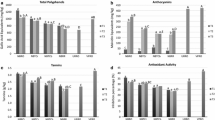Abstract.
The anthocyanin composition of Tempranillo, Garnacha and Cabernet Sauvignon grapes over two vintages was studied. Samples were obtained during berry ripening from two vineyards that differed by producing fruit of high and low quality. The proportions of the individual compounds remained practically constant within a single vineyard along the sampling period, the changes in the anthocyanin composition being principally quantitative. Different multivariate statistical methods showed that the anthocyanin profile was primarily determined by variety. This genetic dependence was particularly verified when the sums of the non-acylated glucosides, the acetates and the p-coumaryl derivatives, were analysed. The mean relative content corresponding to these three anthocyanin fractions was always the same within each variety, independently either of the vineyard or the vintage year considered. Relating to the individual compounds, several permanent qualitative differences between vineyards in each variety were also found, although the difference in the total anthocyanin concentration was always much higher.
Similar content being viewed by others
Author information
Authors and Affiliations
Additional information
Electronic Publication
Rights and permissions
About this article
Cite this article
Arozarena, I., Ayestarán, B., Cantalejo, M. et al. Anthocyanin composition of Tempranillo, Garnacha and Cabernet Sauvignon grapes from high- and low-quality vineyards over two years. Eur Food Res Technol 214, 303–309 (2002). https://doi.org/10.1007/s00217-001-0471-0
Received:
Issue Date:
DOI: https://doi.org/10.1007/s00217-001-0471-0




